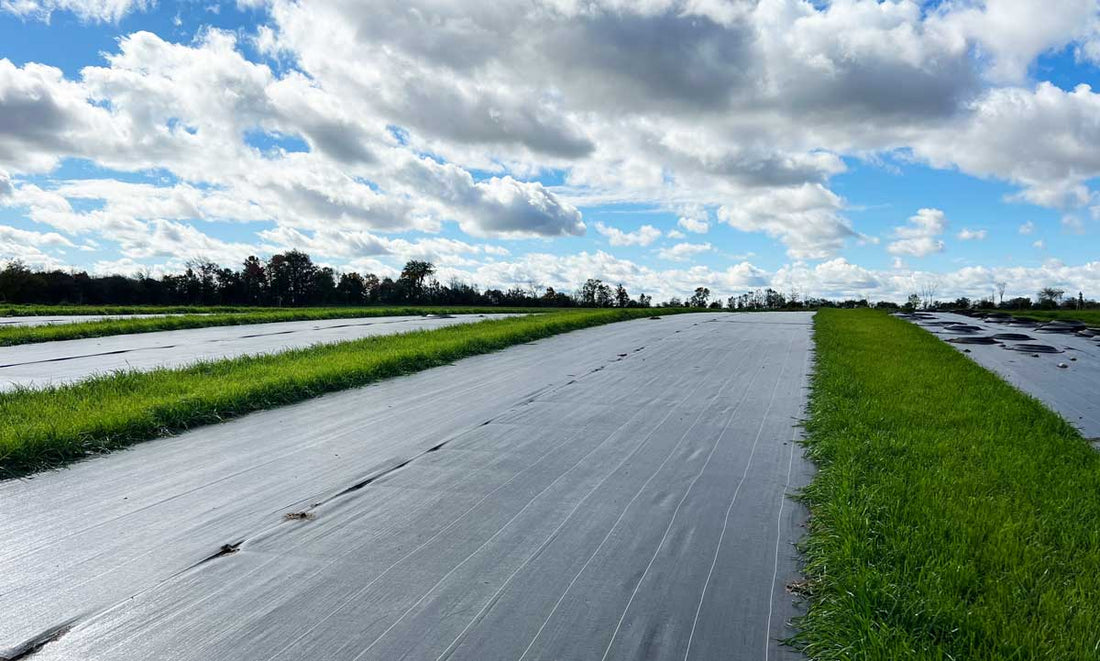
Experimental Acres – Year 1 Observations
In April we posted about our plan for funding received through Wellington County’s Experimental Acres program.
In short, we are testing a no-till preparation of lavender fields by laying a plastic weed barrier fabric directly onto a hay field.
The theory was that the weed barrier would “steam” the hay plants underneath and kill off the plants naturally. The hope was that the plants and their roots would decompose, and release nutrients back into the soil. And, leave behind drainage channels in the soil.
As temperatures are dropping and frost and snow are settling in, I felt it was time to reflect on the experiment’s progress.
Observation #1: The hay seems to be dead
We laid the weed barrier down in May and June, and when we pulled up the plastic in early October, all signs of plant matter were gone!
In its place is evidence of earthworm and other insects and microbes enhancing the soil. There are lots of small soil mounds/balls and holes into the ground. The worms, insects and microbes have been busy digesting the decomposing hay plants and returning those nutrients back into the soil.
We won’t fully know until next year if we completely killed off the hay. This will be more evident next summer when we burn holes into the plastic weed barrier to plant our new lavender. When the soil is exposed to sunlight again, some of the plants may sprout back up.
#2a: Tilling is not needed…
We did till one section of the experimental acre to use as a comparison to the rest. We went over this section 3-4 times with a cultivator to break up the hay roots.
I didn’t expect to find anything major, but a couple of interesting things did come up. Most importantly, there was no visible difference by October 1 between the section we tilled and the sections where we laid the weed barrier directly onto the field. This means tilling/cultivating is not needed!
In fact, tilling actually created more work. In the section we tilled, stones and rocks were worked up out of the soil. This meant we had to manually pick them up before laying the barrier, and added an extra step to the process.
#2b: … But mulch might be needed
Another downside to tilling is that you “wake up” the dormant seeds in the soil. We left two strips of the hay field unmanaged. This means we let the hay grow during the whole season without cutting it. One section was untouched from spring to fall and this stayed mostly in long grasses. The other section was tilled in late May. The plants that came back in this section were mostly weeds – and nasty ones. It seems the tilling weakened the grasses enough for weed seeds in the soil to take over.
Next summer we will burn holes in the weed barrier to plant lavender. After seeing how many weeds popped up in the tilled section, I think we might need to put a small amount of mulch around the baby plants after they are planted. This will block the sun and hopefully stop dormant weeds seeds from germinating in the soil.
#3: Drainage was improved
Prior to putting down the weed barrier, Jordan Grigg, Sustainability Programme Coordinator at the County of Wellington, helped us by doing an infiltration test. Basically, it is a test that measures how quickly an amount of water will infiltrate the soil.
Jordan came back in early October to do the same test and we saw an improvement in the time!
These tests are impacted by the weather (how much rain recently fell), but we saw a dramatic decrease in the time it took for the water to infiltrate the soil. This indicates that there was some improvement, which is very important for lavender. The plants do not like water sitting around their roots. The quicker the soil drains, the healthier our plants will be.
#4: This method takes a lot of physical effort
Although we did avoid the use of a tractor for the majority of the experimental acre, a lot of physical labour was required. I worked slowly at measuring and rolling out the weed barrier and hammering in the landscape staples, but it was tough work. You also need to wait for the soil to be dry and the wind to be low, so timing needs to be right.
This wouldn’t be a wise plan for farmers with physical restrictions. Due to the labour required, I also don’t think it would be a wise plan for more than an acre. You could maybe do two or three acres in a summer, but it would take a team of people and quite a bit of time.
Recap on our lavender hypothesis
By covering with weed barrier fabric for a yearlong cycle, we hoped to do the following and here’s what we’ve found so far:
- Reduce greenhouse gas emissions? – Yes - no tilling needed!
- Preserve soil structure? – Yes, we think so! Based on infiltration tests and visual observations, it seems the soil structure has been maintained and even improved!
- Avoid the use of herbicides? – Yup, no sprays needed for small lavender acreage. Manually pulling will be required next year and likely mulch.
- Avoid compaction that occurs when plowing with a tractor – Yes, no tractor needed.
- Utilize the hay crop as a natural fertilizer – TBD Next spring, we will test the soil again so we can compare the nutrients from Year 1 to Year 2. This will help us understand if nutrients were returned to the soil (hopefully the hay will have acted as a natural fertilizer). We did add compost to the field before we put down the weed barrier, so that will need to be considered in our calculations.
Overall I’m really happy with the results of our experiment. We’ll learn even more next year when we plant the lavender and can observe how it grows and survives in winter. Lavender is a perennial, so much of this experiment is long-term. So far though, it’s been worth the wait.
I want to add a very special thanks to Jordan Sustainability, Programme Coordinator at the County of Wellington, for her support with soil testing and advice on designing our experiment! And of course, a big thanks to the County of Wellington for their financial support.
Xo, Stephanie

2 comments
Stephanie, you are amazing. I can read the passion you have for your farm and lavender. I am so proud of you and wish nothing but success in your business.
So happy for you guys that things seem to be working! Keep up the good work!
Wish you much success!